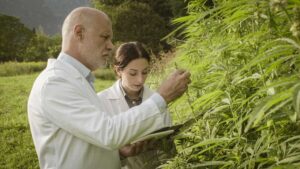Physical Address
23,24,25 & 26, 2nd Floor, Software Technology Park India, Opp: Garware Stadium,MIDC, Chikalthana, Aurangabad, Maharashtra – 431001 India
Physical Address
23,24,25 & 26, 2nd Floor, Software Technology Park India, Opp: Garware Stadium,MIDC, Chikalthana, Aurangabad, Maharashtra – 431001 India

Parliamentary Committee was established under the direction of President Ranil Wickremesinghe to legalise Cannabis as an export product. The committee’s first official meeting was held on 4th October. At the recent budget discussion also, the President stated, “The possibilities of producing Triloka Wijayapathra purely for the purpose of exports will be examined for which an expert committee will also be set up,”
Following the statement, many social media posts promoting Cannabis or “Kansa” went viral in Sri Lanka. Some of the main claims made in these posts were,
Many of these statements suggest that Cannabis, compared to other plants, is more helpful in fighting climate change. Hence, we investigated the truth behind these statements. We spoke to Dr L.P.A Karunathilake, senior lecturer at the Institute of Indigenous Medicine at the University of Colombo and Dr Wasantha Weliange, a veteran in Cannabis Science from Sri Lanka, regarding the subject.
Cannabis or Cannabis sativa is termed ‘Kansa’ in Sinhala and Trailokyavijaya in Sanskrit. According to Dr Weliange, the plant growing in Sri Lanka can be found in two forms, tall plants and shrubs. The tall plant is commonly termed Hemp and is mainly used for its strong fibre, and the short plant is rich in Tetrahydrocannabinol (THC) used for medicinal purposes.
The plant has a growth period of 4 months. It is considered Carbon negative
as it absorbs more carbon from the atmosphere during its growth than the amount
emitted by the equipment used to harvest, process and transport it.
Additionally, Dr Weliange stated that the shape of Cannabis sativa leaf, a palmately compound with three to nine leaflets with toothed margins, gives it an increased surface area, which makes the process of photosynthesis (absorbing carbon dioxide and releasing oxygen to produce starch) very efficient. Due to this reason, Cannabis acts as a very efficient carbon sink.
Most plant species use the C3 photosynthesis process. However, many types of grasses including corn, sugarcane, and hemp are capable of producing a relatively large amount of oxygen by using the C4 photosynthesis process. More on this here
Hemp can capture atmospheric carbon twice as effectively as forests, according to Cambridge University researcher Darshil Shah, senior researcher at the Centre for Natural Material Innovation. He also mentioned that numerous studies estimate that hemp is one of the best CO2-to-biomass converters, and It’s even more effective than trees.
Industrial hemp absorbs between 8 to 15 tonnes of CO2 per hectare of cultivation. In comparison, forests typically capture 2 to 6 tonnes of CO2 per hectare per year, depending on the number of years of growth, the climatic region, the type of trees etc. Read more about this here.
In addition, Hemp paper can be recycled up to 8 times, compared to just 3 times for paper made from wood pulp according to a publication in Woodland Paper.
Dr Weliange stated that all mammals and other animal species except insects possess the endocannabinoid system, which comprises a vast network of chemical signals and cellular receptors. These cannabinoid receptors bind with TSH and CBD present in Cannabis, enhancing the physiological performances in the body. Due to this, insect attacks on cannabis plants are limited compared to other plant species.
In Sri Lanka, Cannabis is legally sold through Ayurveda herbal shops and can be used for medical and scientific purposes if given a license by the Ministry of Health. For recreational usage, cannabis is not legal.
Dr Karunathilake stated that cannabis has medicinal properties of anaesthetics, painkillers, digestion stimulators and overall strengthening of health. However, he highlighted that this could only be purchased and consumed with an Ayurvedic prescription. He mentioned that it is not recommended for people of good health to be used it for recreational purposes. Cannabis plants or derivatives when used internally can give the effects of narcotics when used for a long time with small doses and a short period with higher doses. Due to this, there is a higher possibility of addiction when consumed without medical advice. He also added that cannabis is exported to countries that use it mainly as a treatment for stress.
On the contrary, Dr Weliange stated that the likelihood of getting addicted to Cannabis is less compared to alcohol and tobacco, read the effects here, Archived. Although, he stated that If cannabis is to be used by people with psychosis or clinical depression, it would be detrimental due to the high percentage of THC present. He suggested that such patients should consume cannabis with CBD concentration. Dr Weliange highlighted that if cannabis is legalized in Sri Lanka, there needs to be proper research on cannabis science. Existing research on cannabis suggests that Cannabis is an ideal crop, which could assure higher economic benefits under low inputs. While serving as a venture of foreign earnings, local cultivation would halt the country’s dependency on importing Cannabis-based raw materials. However, legalization and cultivation should be rigorously monitored by an authorized body to ensure that the production meets health regulations and is utilized accordingly.
He also added that it is essential to educate and create awareness among the public regarding its uses before it is legalised. He published a book in 2020 on “Policy Planning for Cannabis” to ensure that Sri Lanka is ready for such a step.
Watch our interview with Dr Wasantha Sena Weliange here
Watch the Documentary on the Climate Fact Checks investigation in Thanamalwila here